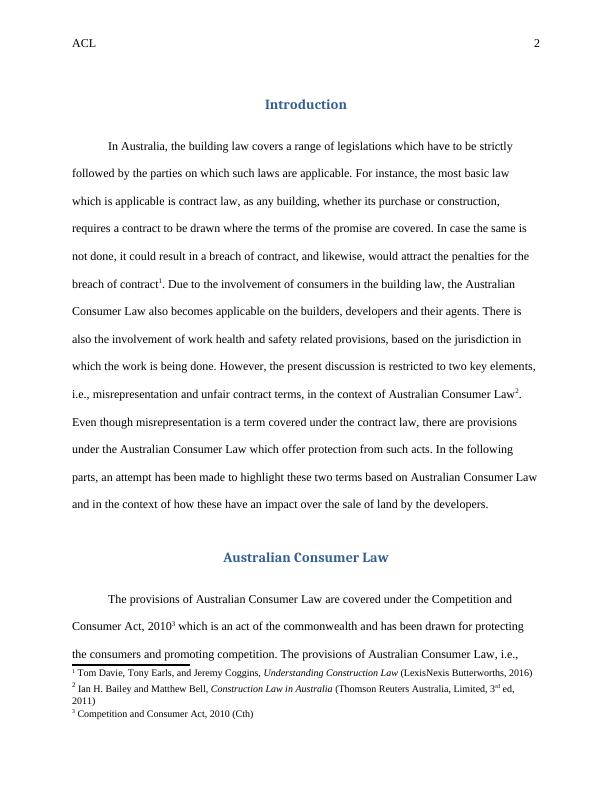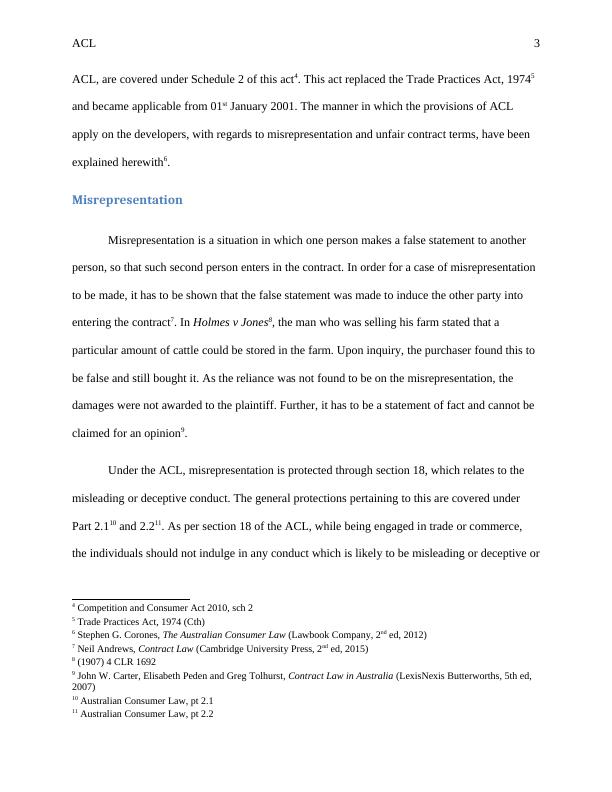200292 - Building Law - Case study
Added on 2020-03-02
12 Pages3252 Words124 Views
qwertyuiopasdfghjklzxcvbnmqwertyuiopasdfghjklzxcvbnmqwertyuiopasdfghjklzxcvbnmqwertyuiopasdfghjklzxcvbnmqwertyuiopasdfghjklzxcvbnmqwertyuiopasdfghjklzxcvbnmqwertyuiopasdfghjklzxcvbnmqwertyuiopasdfghjklzxcvbnmqwertyuiopasdfghjklzxcvbnmqwertyuiopasdfghjklzxcvbnmqwertyuiopasdfghjklzxcvbnmqwertyuiopasdfghjklzxcvbnmqwertyuiopasdfghjklzxcvbnBuilding LawACL(Student Details: )

ACL2IntroductionIn Australia, the building law covers a range of legislations which have to be strictly followed by the parties on which such laws are applicable. For instance, the most basic law which is applicable is contract law, as any building, whether its purchase or construction, requires a contract to be drawn where the terms of the promise are covered. In case the same is not done, it could result in a breach of contract, and likewise, would attract the penalties for the breach of contract1. Due to the involvement of consumers in the building law, the Australian Consumer Law also becomes applicable on the builders, developers and their agents. There is also the involvement of work health and safety related provisions, based on the jurisdiction in which the work is being done. However, the present discussion is restricted to two key elements, i.e., misrepresentation and unfair contract terms, in the context of Australian Consumer Law2. Even though misrepresentation is a term covered under the contract law, there are provisions under the Australian Consumer Law which offer protection from such acts. In the following parts, an attempt has been made to highlight these two terms based on Australian Consumer Lawand in the context of how these have an impact over the sale of land by the developers.Australian Consumer LawThe provisions of Australian Consumer Law are covered under the Competition and Consumer Act, 20103 which is an act of the commonwealth and has been drawn for protecting the consumers and promoting competition. The provisions of Australian Consumer Law, i.e., 1 Tom Davie, Tony Earls, and Jeremy Coggins, Understanding Construction Law (LexisNexis Butterworths, 2016)2 Ian H. Bailey and Matthew Bell, Construction Law in Australia (Thomson Reuters Australia, Limited, 3rd ed, 2011)3 Competition and Consumer Act, 2010 (Cth)

ACL3ACL, are covered under Schedule 2 of this act4. This act replaced the Trade Practices Act, 19745and became applicable from 01st January 2001. The manner in which the provisions of ACL apply on the developers, with regards to misrepresentation and unfair contract terms, have been explained herewith6. MisrepresentationMisrepresentation is a situation in which one person makes a false statement to another person, so that such second person enters in the contract. In order for a case of misrepresentation to be made, it has to be shown that the false statement was made to induce the other party into entering the contract7. In Holmes v Jones8, the man who was selling his farm stated that a particular amount of cattle could be stored in the farm. Upon inquiry, the purchaser found this to be false and still bought it. As the reliance was not found to be on the misrepresentation, the damages were not awarded to the plaintiff. Further, it has to be a statement of fact and cannot be claimed for an opinion9. Under the ACL, misrepresentation is protected through section 18, which relates to the misleading or deceptive conduct. The general protections pertaining to this are covered under Part 2.110 and 2.211. As per section 18 of the ACL, while being engaged in trade or commerce, the individuals should not indulge in any conduct which is likely to be misleading or deceptive or4 Competition and Consumer Act 2010, sch 25 Trade Practices Act, 1974 (Cth)6 Stephen G. Corones, The Australian Consumer Law (Lawbook Company, 2nd ed, 2012)7 Neil Andrews, Contract Law (Cambridge University Press, 2nd ed, 2015)8 (1907) 4 CLR 16929 John W. Carter, Elisabeth Peden and Greg Tolhurst, Contract Law in Australia (LexisNexis Butterworths, 5th ed, 2007)10 Australian Consumer Law, pt 2.111 Australian Consumer Law, pt 2.2

ACL4does actually mislead or deceive12. In the case of Mike Gaffikin Marine Pty Ltd v Princes Street Marina Pty Ltd13, the false statements which were made during the negotiations were held to be misleading or deceptive conduct. This section provides the remedy in form of ancillary order for varying of the drawn contract. For the developers in the nation, they would be deemed to be indulged in misleading or deceptive conduct when they make false statements during the course of negotiations. Also, it is not necessary that such false statement has to be made while being in the physical presence of the seller. The statements made through the adverts placed in magazines or newspapers, the letters, and the emails, all would make them liable for the breach of section 18 of the ACL, if it contains a misrepresentation14. Such statements could relate to a factually wrong statement, which results in the creation of a false impression. Also, the non disclosure of crucial and substantial information to the buyer would also contribute towards a misleading or deceptive conduct, as non disclosure is also deemed false statement. In the similar manner, when crucial information is left out or concealed, or the client is deliberately not provided the updated data or a misunderstanding is willfully not correct, or even the making of inaccurate or false claims would result in the breach of provisions of section 1815. Another leading example is the photographic enhancement. The photographs of the property which are touched up for hiding the characteristics which are not desirable and where the features are enhanced could also mislead the consumers. So, the developers should refrain from modifying or allowing the modified photographs to represent the property when they do not12 Australian Consumer Law, s1813 17 ACSR 49514 Dilan Thampapillai, Vivi Tan and Claudio Bozzi, Australian Commercial Law (Cambridge University Press, 2015)15 Department of Commerce WA, Australian Consumer Law (2013) <https://www.commerce.wa.gov.au/sites/default/files/atoms/files/aclagentsmanual2013_0.pdf>

End of preview
Want to access all the pages? Upload your documents or become a member.
Related Documents
Construction Management Building Lawlg...
|14
|3569
|42
Construction Law - ARBE1301 | Assignmentlg...
|11
|2396
|77
Australian Consumer Law || Australian Legal Systemlg...
|10
|3270
|94
BUS307 - The Australian Consumer Lawlg...
|11
|2960
|64
Building Laws | Australian Consumer Law ( ACL )lg...
|10
|2747
|155
Context of breach Assignment PDFlg...
|19
|921
|40
